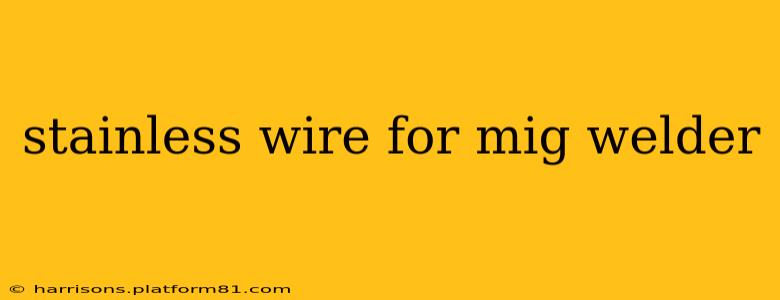MIG welding stainless steel requires specialized wire to achieve strong, corrosion-resistant welds. Choosing the right wire is crucial for a successful outcome. This guide delves into the nuances of stainless steel MIG welding wire, addressing common questions and concerns.
What Type of Wire is Best for MIG Welding Stainless Steel?
The best wire for MIG welding stainless steel depends on the specific grade of stainless steel you're working with and the desired weld characteristics. Generally, you'll find wires classified by their chemical composition, primarily focusing on the chromium and nickel content. Common choices include:
-
304L Stainless Steel Wire: This is a very popular choice due to its excellent corrosion resistance and weldability. It's suitable for a wide range of applications. The "L" designation indicates a low carbon content, minimizing the risk of carbide precipitation which can cause weld cracking.
-
308L Stainless Steel Wire: Often used as a filler metal for welding 304 and 304L stainless steel, offering similar corrosion resistance and weldability.
-
316L Stainless Steel Wire: This wire provides even greater corrosion resistance than 304L, making it ideal for applications exposed to harsh environments like marine or chemical processing. The added molybdenum enhances its resistance to pitting and crevice corrosion.
-
309L Stainless Steel Wire: This offers higher strength and corrosion resistance compared to 304L and is often chosen for high-temperature applications.
Selecting the correct wire diameter is also important. Thicker wire is better suited for thicker materials and higher amperage, while thinner wire is preferred for thinner materials and lower amperage. Always check the manufacturer's recommendations for optimal wire diameter based on your welding machine and material thickness.
What is the Difference Between ER308 and ER308L Stainless Steel Wire?
The key difference lies in the carbon content. ER308 contains a slightly higher carbon content than ER308L. This higher carbon content in ER308 can lead to carbide precipitation during welding, potentially causing weld cracking, particularly in thicker sections. ER308L's lower carbon content minimizes this risk, making it the preferred choice for most stainless steel welding applications.
What Gas Should I Use for MIG Welding Stainless Steel?
The most common gas for MIG welding stainless steel is a shielding gas mixture, typically composed of argon and a small percentage of carbon dioxide or oxygen. These mixtures help to protect the weld pool from atmospheric contamination, ensuring high-quality welds. Specific gas mixtures may vary depending on the type of stainless steel being welded and the welder's preference. Using the correct shielding gas is vital to prevent porosity and other weld defects.
How Do I Choose the Right Diameter of Stainless Steel Wire?
The optimal wire diameter depends on the thickness of the stainless steel being welded and the amperage your MIG welder can output. Thicker wires are generally used for thicker materials and higher amperages, while thinner wires are best for thinner materials and lower amperages. Consult your welder's manual and the wire manufacturer's specifications for appropriate diameter recommendations. Using the wrong diameter can lead to poor weld penetration, excessive spatter, or other issues.
Can I Use Regular MIG Wire on Stainless Steel?
While it might seem tempting to save money, using regular mild steel MIG wire on stainless steel is strongly discouraged. The resulting weld will have significantly reduced corrosion resistance and mechanical properties. This could lead to premature failure and compromise the integrity of the entire structure. Always use stainless steel wire specifically designed for welding stainless steel.
What is the Best Shielding Gas for 304 Stainless Steel?
For 304 stainless steel, a mixture of 98% Argon and 2% Oxygen is commonly used. This mixture provides excellent shielding and weld quality. Some welders also prefer using a blend of Argon and CO2, but it is crucial to maintain the correct blend ratio to avoid weld defects.
This comprehensive guide offers a solid foundation for understanding stainless steel MIG welding wire. Remember to always consult the manufacturer’s specifications for the precise requirements of your project and to prioritize safety when welding.
